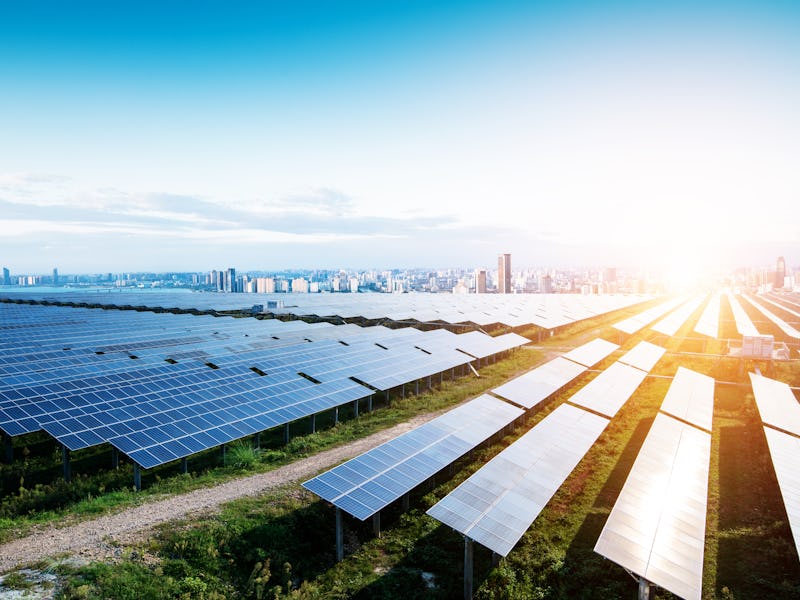Emerging solar star has a toxic backstory, but scientists have a solution
By recycling nearly 100 percent of the lead, this process is an almost closed processing loop.

Within the ecosphere of solar panel technology, perovskite panels have emerged in recent years as a superior alternative to traditional silicon panels. With two million solar panels installed in the U.S. alone, swapping old silicon models for a perovskite upgrade could have a big impact — perovskite panels are more efficient, cheaper, and more scalable.
But they also have an Achilles heel that could threaten their solar dynasty: lead. Fabrication, as well as wear-and-tear, can cause these panels to leach lead into their environment, potentially putting people's health and safety at risk.
To solve this problem, an international team of scientists has devised a way to sustainably collect these pollutants without sacrificing the panel itself. Using this new approach, the scientists were able to safely recycle 99.7 percent of lead in their samples.
In the study describing their work, published Monday in the journal Nature Sustainability, researchers explain that they're not the first to attempt to tackle this question, but that previous approaches to adsorbing lead have been limited by the number of naturally occurring lead solvents.
"Managing Pb via recycling represents a promising approach to mitigating its toxicity. However, managing Pb from commonly used organic solvents has been challenging due to the lack of suitable Pb adsorbents," explain the authors. "The adsorption approach is one of the best candidates because it can enhance the reactivity with Pb, making it easy to retrieve from the solution."
Similar to an air filter, the authors explain that their goal is to collect the polluted material from solar panels, pass it through their adsorption process, and return a lead iodide to the manufacturers to be reused — thus creating a sustainable, (mostly) closed processing loop.
How does it work — In order to do this, the team engineered a special way to adsorb lead from the perovskite solar cells. Importantly, this process is different from absorbing the lead, which would imply that the entire toxic substance was somehow enveloped. Instead, this adsorption process works by clinging to the surface of the lead and separating it through magnetic fields. Kind of like how you might try to grab a small object using static cling alone.
This multi-step adsorption process was able to recycle 99.7 percent of lead from the panels.
Their process starts at the solar cell manufacturing plant with panels that are slowly degraded over time from lead. This lead is then melted off the panels using a dissolving process and taken to a specialized adsorption chamber that uses a magnetic field to separate lead ions from other pollutants.
Once separated, the cleaned lead can then be recycled back to the manufacturers in the form of lead iodide to be used in the creation of more solar cells. The authors write that the incorporation of iron into their adsorbent made the collection of lead even easier.
"[Our] recycled PbI2 is comparable in quality to commercial PbI2; thus, our study enables a zero-lead-emission route for future perovskite technologies," write the authors.
The researchers say that they were able to recycle nearly all lead passed through their adsorbents for a recycling yield of 99.7 percent. They were also able to meet Environmental Protection Agency guidelines for the level of lead permitted in a solution after their separating process.
Ultimately, the team writes, this study demonstrates the potentials of using economical, as well as bio- and environmentally friendly, adsorbents in heavy metal management.
"Our approach paves a way for [pervoskite solar cell] manufacturing with zero Pb emission and, by extension, provides the methodology for recycling and managing lead from waste devices to allay concerns on Pb-related environmental issues," the authors say.
Abstract: Despite the rapid development of perovskite solar cells (PSCs) toward commercialization, the toxic lead (Pb) ions in PSCspose a potential threat to the environment, health and safety. Managing Pb via recycling represents a promising approach to mitigating its toxicity. However, managing Pb from commonly used organic solvents has been challenging due to the lack of suitable Pb adsorbents. Here, we report a new adsorbent for both separation and recovery of Pb from PSC pollutants. The synthesized iron-incorporated hydroxyapatite possesses a strongly negatively charged surface that improves electrostatic interaction through surface-charge delocalization, thus leading to enhanced Pb adsorption. We demonstrate the feasibility of a complete Pb management process, including the purification of Pb-containing non-aqueous solvents below 15 parts per 109, a level compliant with the standards of the US Environmental Protection Agency, as well as recycling of 99.97% of Pb ions by forming lead iodide.
This article was originally published on